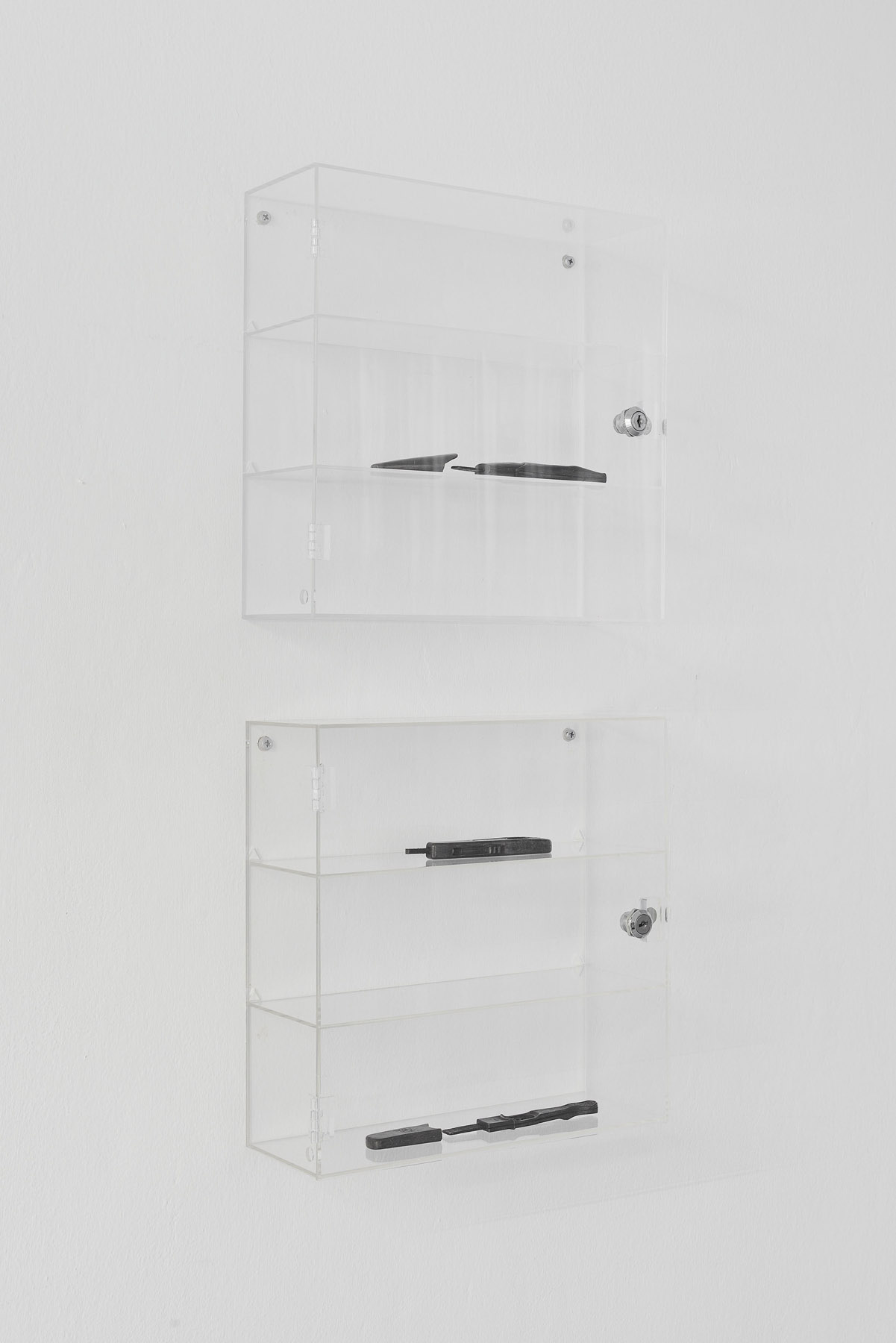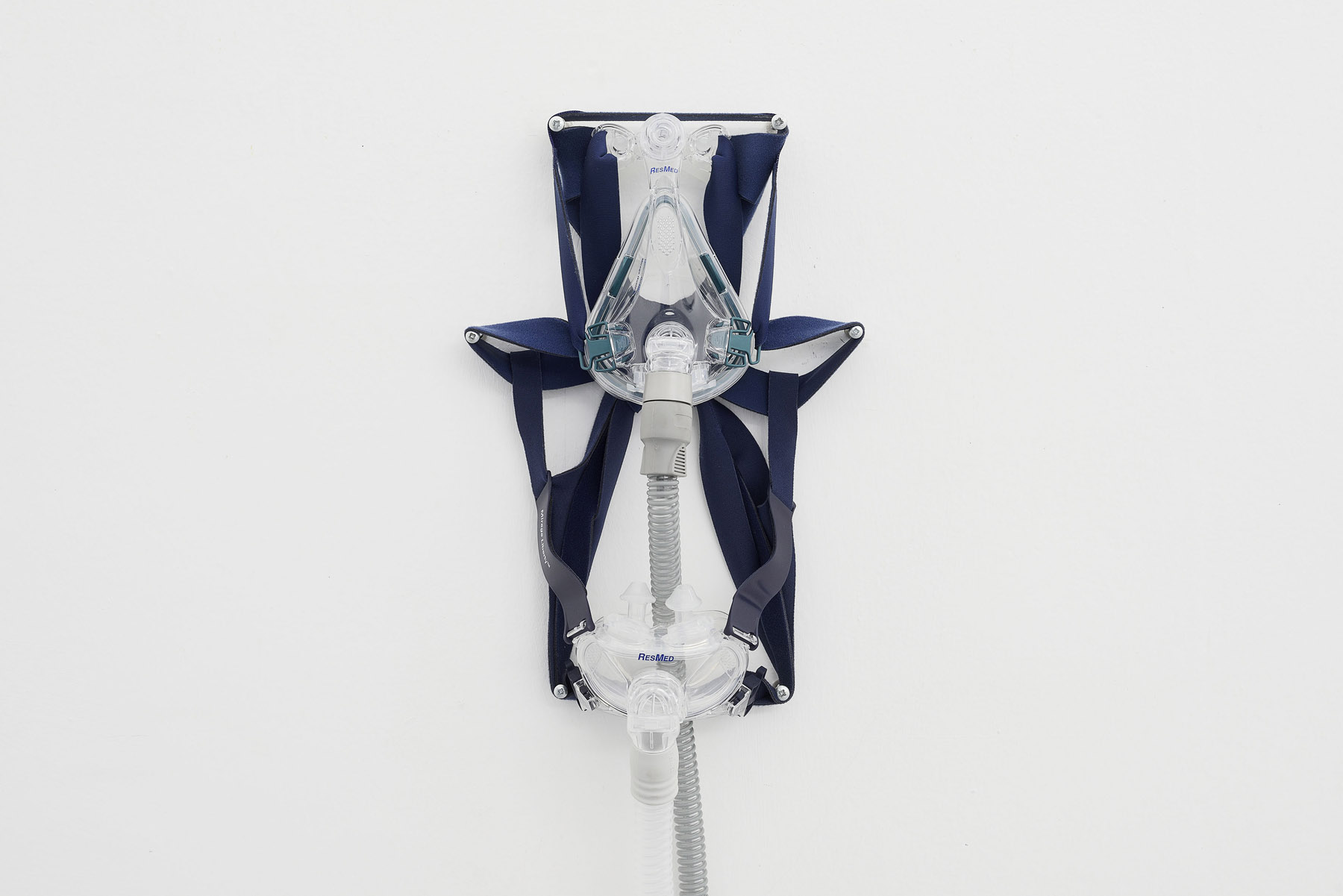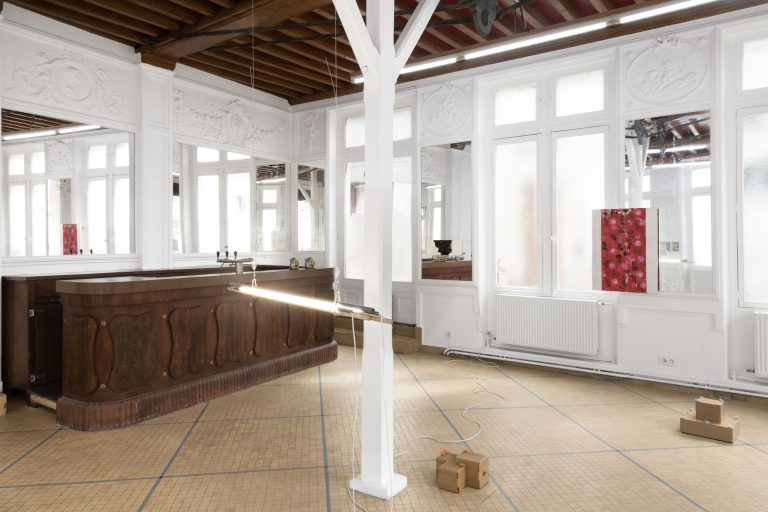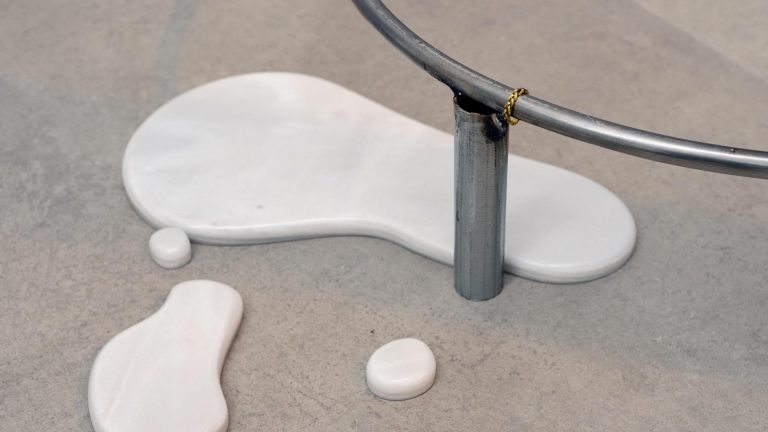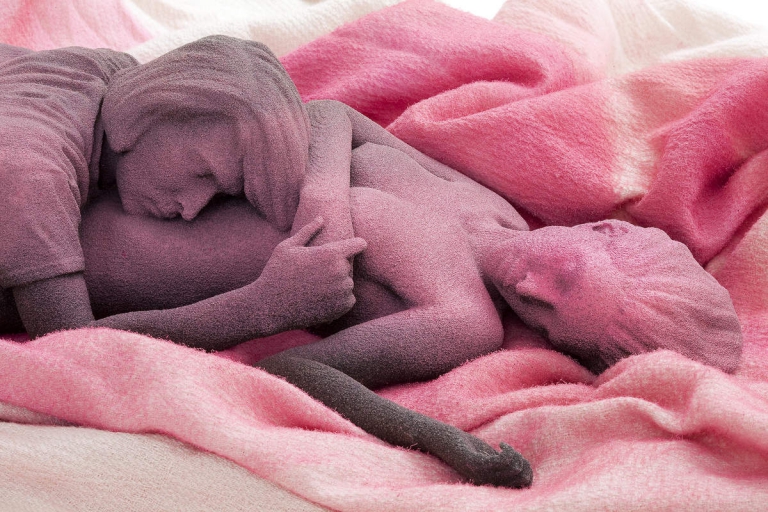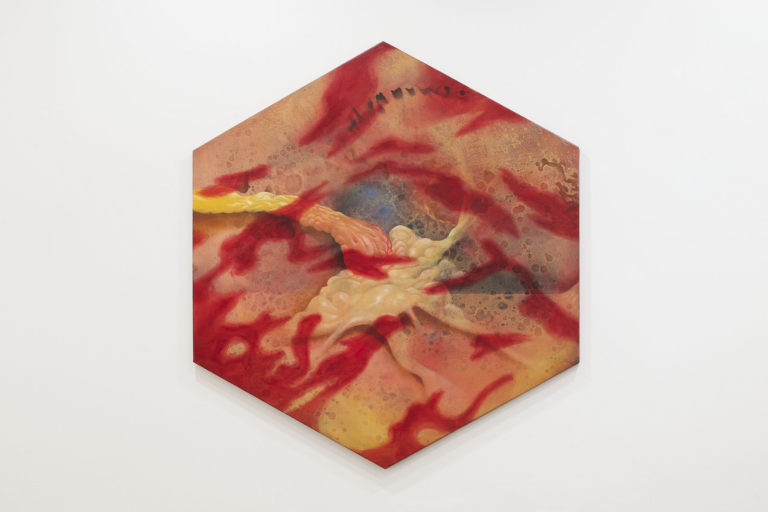Artists: Gina Folly, Hannah Levy, Ebecho Muslimova, Berenice Olmedo, Athena Papadopoulos, Jenna Sutela
Exhibition title: Incorporea #2
Venue: Basement Roma, Rome, Italy
Date: October 23, 2020
Photography: Roberto Apa, all images copyright and courtesy of the artists and Basement Roma
INCORPOREA is a year-long choral exhibition conceived by CURA. for its exhibition space BASEMENT ROMA, set up as to develop and transform itself over time, and aimed at investigating the body in all its folds and meanings: the body in its presence and absence, the social body, the body as a revolutionary space, of antagonism and freedom, expression and research, self-definition and power, identity and gender. Going across different generations and media, starting from new artistic expressions and going back towards the historical avant-gardes, INCORPOREA will investigate the practices that have uncovered, transformed and re-imagined the body and the speculations it has inspired. Moving around the boundaries, meanings and shapes of the body, the exhibition intends to introduce a new corpus of works every month in a sort of endless movement, a constant flow of addition and subtraction, with the aim of exploring an urgent and significant theme, articulating the elements that define it beyond preconceived categories, in today’s ever-shifting scenario.
GINA FOLLY
(born Zurigo, Switzerland in 1983, lives and works in Basel and Paris)
Like caskets holding questions on existence, Gina Folly’s objects contain a semantic universe, built by the artist through a juxtaposition of metaphors. The works become devices of meaning [placeholders] that can activate thoughts and ask questions.
Those that at first glance look like ordinary work tools turn out to be the bronze casts of equally common pregnancy tests. Untitled 1, Untitled 2 and Untitled 5 (2020) are new instruments with a deliberately mechanical appearance, giving the impression of no longer addressing the maintenance of inanimate objects, but rather the control over the human body, a biological device that needs care, testing and overhauling. The gears that allow these bodily mechanics to work elicit new interactions and measurements, transforming flesh into a mechanical contraption.
Switching from the ephemeral [literally disposable] nature of plastic to the persistence of bronze, the test results keep waiting to be revealed, locked forever in a material that does not undergo oxidation. When its result is positive, a pregnancy test strip turns into the evidence of existence, it indicates life that is renewed and reveals the presence of a body within another body. But in Folly’s strips the test window that should indicate the outcome of this modern Annunciation remains unchanged, projecting into the future a question doomed not to be answered: will there even be a body in the future?
(text by Leonardo Caldana)
Selected solo exhibitions include: Fashion, Sex and Death — Science — Sports, Gardens and Conspicuous Consumption, Jahresaussenprojekt, Kunsthaus Baselland, Basel (2019), Casa Tomada / House Taken Over, curated by Anna Goetz, Mexico City (2018); Double Fantasy, Hard Hat, Geneva (2018), Follow You, A project by Belo Campo, Galeria Francisco Fino, Lisbon (2017); Other Life, Studioli, Rome (2017); I want you to live in my city, Ermes-Ermes, Vienna (2017); Temporarily Unavailable, Ginerva Gambino, Cologne (2017), Domestic Problems, Almanac, London (2016). Among selected group shows: We Don’t Like Your House Either!, Monitor, Rome (2020), The Estate, Kim? Contemporary Art Centre, Riga (2019); LIFE AND LIMBS, Swiss Institute, New York (2019); NOI, Museion, Bolzano (2019).
HANNAH LEVY
(born in New York in 1991, lives and works in New York)
Hannah Levy explores the figure and its politics through the objects we surround ourselves with. In her world, the living and the inanimate act as one—all gesturing in their own way towards the same truths. Levy stresses this fluidity by taking conflation to its logical extreme. In her sculptures, the things we consume (baguettes and croissants) are indistinguishable from the surfaces (tables, tiles and chairs) upon which we serve them and the structures (arms and hands) that bring them inside us. Her work disguises itself as mundane to hide its ambition. It is not about creating bodily ambience; it’s about looking at the values these relationships betray.
Tactile seduction is germane to Levy’s installations and sculptures. This physical collapse between intimate and commercial space helps sew together Levy’s thesis. Material attraction becomes more than a punch line or come-on. It is a skin that reminds the viewer of their own touch.
The close-to-home-ness of Levy’s message is the source of its horror and its humor. In placating her viewer with the familiar and its antecedents, she buries them alive. The body is not a safe space but a battleground, and the consequences of that conflict extend into everything that surrounds us. How does one escape these insidious patterns? Levy doesn’t offer us an answer, but she does offer hope. Like her sculptures, these ideas are not impervious but fragile and impermanent like their models. Capable of breaking under the slightest tug or bite, her dysfunctional furniture and food suggest that the values they hold are just as malleable, and that perhaps other values, and another world, may yet be possible.
(excerpt from Design Within Reach. Hannah Levy, by Kat Herriman, CURA. 28)
Among her recent solo shows: Hannah Levy: Pendulous Picnic, Casey Kaplan, New York, Bone-In, Jeffrey Stark, New York, Panic Hardware, Mother’s Tankstation. Selected group exhibitions include: The new frontiers of the contemporary, Fondazione Coppola, Vicenza, Italy, Campi Magnetici (Magnetic Fields), Gio Marconi, Milan (curated by Ceclia Alemani), Wege zur Welt – Hildebrand Collection, G2 Kunsthalle, Leipzig, Insane in the Membrane, Sammlung Philara, Düsseldorf and The Artist is Present, Yuz Museum, Shanghai, China (curated by Maurizio Cattelan).
EBECHO MUSLIMOVA
(born in Russia in 1984, lives and works in New York)
In a nightmare common to fits of insecurity, you walk the halls of your office or college campus, naked and unkempt. You recognize the reality of your hunching body and exposed privates, but only after they have been the focus of peer attention for an ambiguous amount of time. The concern is not necessarily that it happened but that you did it unintentionally—you somehow let this happen, which means you have lost the essential part of your mind that compartmentalizes these two selves.
The artist Ebecho Muslimova invented Fatebe (pronounced “fat eebee”) when she had a day job at a corporate office. Fatebe was all ego, a version of the artist’s self sans inhibitions. In an immediate interpretation of the typical insecurity nightmare, she finds herself in public with no beautifying ephemera. But Fatebe feels no shame from this predicament. Instead, she finds pleasure experiencing her precariousness fully, splayed and physically vulnerable while expressing an almost arrogant joy from the amount of space she inhabits. In much of the world, the amount of space a woman’s body takes up has an almost directly inverted relationship to the amount of respect she is rewarded. In Fatebe’s world, she appears to believe the opposite is true—and that exposure is everything. Sometimes, she is mural-sized, expanding across an entire building floor, her cartoon holes and nipples punctuating a clumsy pose. She dares you to call her unsexy, a joke, or unworthy of your attention. Even if you did, she wouldn’t believe it.
Muslimova codifies the echoes of domesticity, luxury, nature, education, psychology, fetish, and art itself—images that have the capacity to haunt her. Nothing can deter Fatebe, though. From her gleeful smile we can assume that her convictions only gain momentum with every new opportunity to test them.
(excerpt from Ebecho Muslimova, by Natasha Stagg, CURA. 30)
She has presented solo exhibitions at: Magenta Plains, New York; Galerie Maria Bernheim, Zurich; 247365, New York; White Flag Projects, Saint Louis; ROOM EAST, New York. She has participated in several group exhibitions including at: FRAC Île-de-France, Paris; Kunst Halle Sankt Gallen; Ellis King, Dublin; Kraupa-Tuskany Zeidler, Berlin; Eva Presenhuber, Zurich; Ramiken Crucible, Los Angeles; Tanya Leighton, Berlin, Delmes & Zander, Cologne. Muslimova created a large-scale mural for The 32nd Biennale of Graphic Arts, Ljubljana, Slovenia in 2017. Muslimova is included in Jeffrey Deitch’s book, Unrealism, featuring 27 artists and major essays by Johanna Fateman, Alison Gingeras, and Aria Dean.
BERENICE OLMEDO
(born in Mexico in 1987, lives and works in Mexico City)
What is normal? What is not? In any field, be it sociology, culture, economics or politics, an attempt is made to identify a “standard.” Somehow, the idea that a rule to which everything must conform has become the norm. […] What does not fall within this framework is thus considered abnormal, as if it were an aberration, an obstacle. And this is what happens with minorities, with those who think differently, with people with disabilities; it even happens with minor physical defects such as a simple hip dysplasia. What does not comply is forcedly made to do so, because that is normality.
The mexican artist Berenice Olmedo focuses on these reflections and themes, explores them, and creates publications, sculptures, installations and performances. Her exhibitions are preliminary reports of all research. The question of the norm, which she investigates in the most varied cases, thus becomes for Olmedo a deep analysis of very different aspects, including contrasts and contradictions, legal conflicts and painful personal stories.
Man, or rather the human body, becomes part the central part of the artist’s installations, after a long period of incubation. In her works, the artist often uses medical devices, corrective orthopedical supports, medical respirators and masks. On the one hand, one feels upset, challenged: these devices represent the vulnerability of the body. At the same time, however, the observation of these sculptures has an entrancing element. The “being different” is therefore as fascinating as the technical aspect of the bodily extensions/corrections.
Berenice Olmedo questions the dominating models of thought and categorization in our society, models that always depend also on social class and income. With her works, the artist critically addresses the difficult issue of homogeneity of object and body within our society, thus our seeing the body as an object, which implies it being granted very few rights. In all of this, the dissolution of borders is most interesting: technical objects become fragile bodies; bodies are transformed into objects and devices. The close link between work and research allows us to see Olmedo’s sculptures and installations not necessarily as “finished” objects, but as complex matters ranging from language to politics to medicine and law.
(excerpt from Berenice Olmedo, by Fabian Schöneich, CURA. 33)
Selected solo shows include: CsO, haecceidad, Jan Kaps, Cologne (2020); Toraco-Lumbo [SKOLIÓPHYSIS], Lodos, Mexico City (2019); Anthroprosthetic, Jan Kaps, Cologne (2018); Bioethics and Biopolitics: The Entry of the Stray Dog into the City System, Escuela de Humanidades, Puebla (2012). Selected group shows include: Dream Baby Dream at Haus Moedrath, Kerpen (2020); and suddenly it all blossoms, 2nd Riga Biennial, Riga; How to Survive, Kunst als Überlebensstrategie, Sprengel Museum Hannover (2020); Selfreconstruction: Detritus, (curated by Abraham Cruzvillegas), Museo Universitario de Ciencias y Arte (MUCA), Mexico City (2018); CyberArts, OÖ Kulturquartier, OK Center, Linz (2017).
ATHENA PAPADOPOULOS
(born in Canada in 1988, lives and works in UK)
Papadopoulos’ works are densely layered surfaces featuring imagery that are at once of a seductive and repulsive nature; they use photographic and hand-drawn elements, t-shirt transfers and textile elements, found objects and other materials to create collages that are made using performative gestures such as spitting medicines and wine, scratching, splashing and staining the surface with cosmetics and bleach. The sculptural paintings here presented are comprised of repurposed textiles imbued with the personal memories of those who have parted with them, focusing on the subjectivity-forming processes and allegorical encapsulations that incubate within a series of floating garments-turned-sculptures. The artist has surgically reconfigured them by transplanting elements of detritus – precious and toxic paraphernalia that act both as infection and cure – onto and into these bodies. In doing so, the artist occupies the position of the surgeon, incising wounds and opening cavities, both treating and exacerbating the dis(eased) bodies at hand; as Papadopoulos notes, by “re-stitching imagery from one ‘body’ of work to the next, to some extent [I am] living my dream of being a plastic surgeon – a profession I was adamant about pursuing as a child”.
These objects then become spectres of a play that mimics relational, psychological, and social dynamics, all imbricated and bound up with the artist’s personal experience, where one gets the impression he or she is reading the artist’s diary, somewhere describing her life with an aggressively lyrical tenure while having accepted a somber state of dystopia.
(excerpt from CURA. – VV. AA.)
Current and forthcoming exhibitions include My Flannel Knickers, Sargent’s Daughters (New York, NY, US, 2020); Future City Shining the Eternal Now, Museum of Contemporary Art (Toronto, CA, 2021) and The Condition of Being Addressable, ICA (Los Angeles, US, 2021). Recent solo exhibitions include Cain and Abel Can’t and Able, MOSTYN Museum (Llandudno, UK, 2020); The Apple Nun, Liebaert Projects (Kortrijk, BE, 2019); Holy Toledo, Takotsubo!, curated by CURA., Kunsthalle Lissabon (Lisbon, PT, 2019). Recent group exhibitions also include: Nine Lipped Goddess, Project Artbeat (Tbilisi, GE, 2020); World Receivers, Zabludowicz Collection (London, UK, 2019); The Marvelous Cacophony, curated by Gunnar and Danielle Kvaran, 57th October Salon (Belgrade, RS, 2018).
JENNA SUTELA
(born in Finland in 1983, lives and works in Berlin)
Notably drawn to the cyberpunk concept of wetware and biocomputing, the artist Jenna Sutela was always inspired by sci-fi and curious about alternative or left cybernetics. Some of these ideas, drawn from the computer-related concepts of hardware and software but applied to biological life forms, made her came across research that explained how there were existing organisms that functioned like natural computers, discovering the single-celled, many-headed yellow species of slime mold that would become one of the central tropes in her work. These creatures, as Sutela tells, are spatially intelligent and can navigate a maze using the shortest possible route to its food source; they are oozy, shapeshifting and can survive in extreme conditions – “I found out that the slime mold was used as a model organism for self-organizing decentralized robotics, so encountering this organism led me to biology and microbes”. Although conceptually driven, Sutela’s work has its own slimy aesthetics, addressing this plastic, primordial quality to the slime, as seen in the stringy nattō bacteria present in fermented soybeans and in her work Holobiont (2018).
She often thinks about “gray goo”, a “hypothetical end-of-the-world scenario involving molecular nanotechnology in which out-of-control self-replicating robots consume all matter on Earth while building more of themselves”. Another point is the strong esoteric vein throughout her work and the intersection between the occult and the technological plays with the idea of the computer being sentient. Narrative is a central part of her work, growing out of science fiction but manifesting itself in different formats. Her focus is more on the poetic than the prose, reflecting a desire to move away from language as we know it – for example, “‘Gut-Machine Poetry’ is a surrealist style cut and paste, but using algorithms.”
Sutela’s work does not solve issues but raises questions about the future and existence of humanity in interesting and often poetic ways by blurring science, technology, poetry and aesthetics. Her practice makes us reconsider how we interpret the world around us and show how meaning and understanding are both enlightening and illusive.
(excerpt from Francesca Gavin, CURA. 35)
Jenna Sutela’s work has been presented at museums and art contexts internationally, including Guggenheim Bilbao, Moderna Museet, and Serpentine Galleries. She is a Visiting Artist at The MIT Center for Art, Science & Technology (CAST) in 2019-2020.
Jenna Sutela, Holobiont (2018), 10’27”, video still. Courtesy the artist.
INCORPOREA, installation view at BASEMENT ROMA. Photo: Roberto Apa
Jenna Sutela, Holobiont (2018), 10’27”, installation view at BASEMENT ROMA. Photo: Roberto Apa
Gina Folly, Untitled 1, Untitled 2 and Untitled 5 (2020), installation view at BASEMENT ROMA. Photo: Roberto Apa
Gina Folly, Untitled 1, Untitled 2 and Untitled 5 (2020). Photo: Roberto Apa
INCORPOREA, installation view at BASEMENT ROMA. Photo: Roberto Apa
Athena Papadopoulos, Repulsive Fantasy (2020), installation view at BASEMENT ROMA. Photo: Roberto Apa
Athena Papadopoulos (detail), installation view at BASEMENT ROMA. Photo: Roberto Apa
INCORPOREA, installation view at BASEMENT ROMA. Photo: Roberto Apa
Athena Papadopoulos, installation view at BASEMENT ROMA. Photo: Roberto Apa
INCORPOREA, installation view at BASEMENT ROMA. Photo: Roberto Apa
INCORPOREA, installation view at BASEMENT ROMA. Photo: Roberto Apa
Hannah Levy, Untitled (2014-15), installation view at BASEMENT ROMA. Courtesy the artist and Casey Kaplan, New York. Photo: Roberto Apa
Hannah Levy, Untitled (2014-15), installation view at BASEMENT ROMA. Courtesy the artist and Casey Kaplan, New York. Photo: Roberto Apa
Ebecho Muslimova, Fatebe Wallpaper (2020), installation view at BASEMENT ROMA. Courtesy the artist and Galerie Maria Bernheim, Zurich. Photo: Roberto Apa
Berenice Olmedo, Homonyme (2018), installation view at BASEMENT ROMA. Photo: Roberto Apa
Berenice Olmedo, Homonyme (2018), installation view at BASEMENT ROMA. Courtesy the artist and Jan Kaps, Cologne. Photo: Roberto Apa
Berenice Olmedo, Homonyme (2018), installation view at BASEMENT ROMA. Courtesy the artist and Jan Kaps, Cologne. Photo: Roberto Apa





